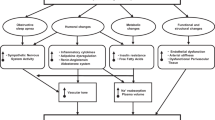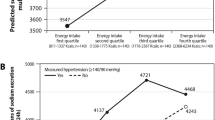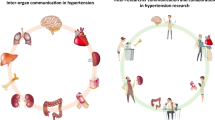Abstract
While the prevalence of hypertension is clearly increased among the overweight persons, the pathophysiological mechanisms underlying this frequent association of obesity and hypertension are still poorly understood. The expansion of extracellular volume, inducing hypervolaemia and increased cardiac output, represents the characteristic haemodynamic feature of the obesity-related hypertension. The maintenance of hypervolemia in the face of elevated blood pressure, indicates a resetting of pressor natriuresis toward higher blood pressure. The development of hypertension also indicates an increase in peripheral vascular resistance, thus the lack of physiological adaptation of peripheral resistance to increased cardiac output. The mechanisms underlying these changes in renal function and vascular reactivity can no longer be attributed to hyperinsulinaemia as such, but might be related to insulin resistance responsible for the enhancement in pressor activity of noradrenaline and angiotensin II. This increased reactivity to pressor factors may be due to an inadequate nitric oxide generation by vascular endothelium and to increased sodium and calcium concentration in vascular smooth muscle cells. The role of increased neuropeptide Y (NPY) activity, may also be involved. As to enhancement of tubular sodium reabsorption, it could be related to histological changes within the renal medulla, leading to compression of tubules and vasa recta, hence a more efficient sodium reabsorption. As to the therapeutic approach, the low-energy sodium-restricted diet associated with increased physical activity, represents the cornerstones of treatment for the obesity-related hypertension. If this approach fails, the pharmacological treatment becomes necessary, and the use of the converting enzyme inhibitors seems to be the most appropriate choice of drug therapy for hypertensive obese patients.
This is a preview of subscription content, access via your institution
Access options
Subscribe to this journal
Receive 12 print issues and online access
$259.00 per year
only $21.58 per issue
Buy this article
- Purchase on SpringerLink
- Instant access to full article PDF
Prices may be subject to local taxes which are calculated during checkout
Similar content being viewed by others
Author information
Authors and Affiliations
Rights and permissions
About this article
Cite this article
Kolanowski, J. Obesity and hypertension: from pathophysiology to treatment. Int J Obes 23 (Suppl 1), S42–S46 (1999). https://doi.org/10.1038/sj.ijo.0800794
Published:
Issue date:
DOI: https://doi.org/10.1038/sj.ijo.0800794
Keywords
This article is cited by
-
Acute and short-term effects of caloric restriction on metabolic profile and brain activation in obese, postmenopausal women
International Journal of Obesity (2016)
-
A rare cardiac finding in a morbidly obese patient with severe hypertension
Internal and Emergency Medicine (2011)
-
The association between body mass index and incident hypertension in rural women in China
European Journal of Clinical Nutrition (2010)
-
Confirming a Biological Pathway in the Metabolic Syndrome—Insight from the NHANES 1999–2002
Obesity (2008)
-
Body weight changes and the A-6G polymorphism of the angiotensinogen gene
International Journal of Obesity (2002)



